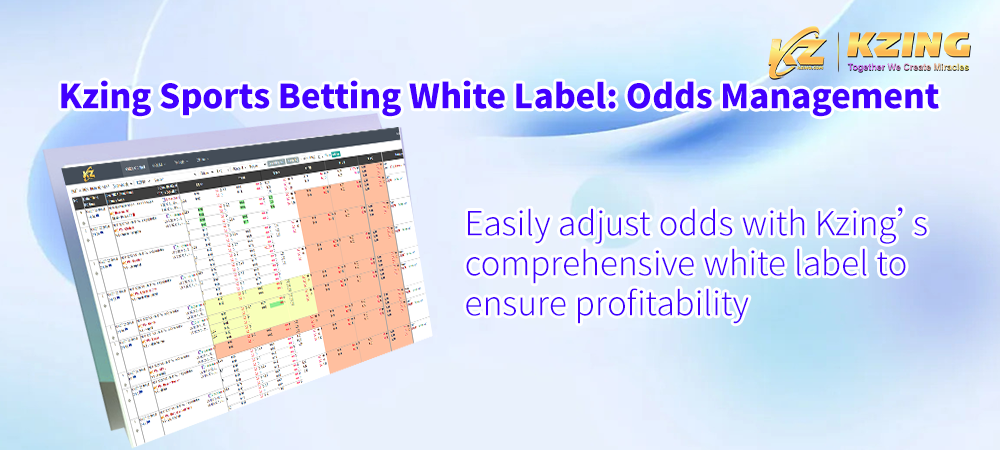

The sports betting industry is thriving, and bookmakers play a pivotal role in its success. For operators and potential operators of sports betting websites, developing profitable odds and sound betting strategies is crucial. Not only must bookmakers create odds that are attractive to bettors, but they also need to ensure that these odds are profitable over the long term. In this article, we will delve into the technical aspects of setting winning odds and managing risk, while highlighting how Kzing’s white label solutions can help streamline these processes and maximize profits.
Table of Contents
Understanding Odds: The Foundation of Profitability
At the core of any successful sportsbook is the science of setting odds. Odds are a reflection of the probability of an event occurring and represent the payout a bookmaker offers. There are three main types of odds—fractional, decimal, and moneyline—that cater to different markets. Setting profitable odds requires not only understanding these formats but also accurately calculating the implied probability and incorporating a margin that ensures profitability.
Calculating Implied Probability
The first step in setting odds is calculating the implied probability of an event. For example, if the decimal odds for a football team to win are 2.50, the implied probability is calculated as:

This means that the bookmaker believes there is a 40% chance of the team winning. However, to ensure profitability, bookmakers add a margin—known as the overround or vig—so that the total probability across all possible outcomes exceeds 100%.
Adding a Margin for Profitability
Let’s consider a simple scenario with two outcomes:
- Team A to Win: Decimal odds = 2.00, Implied Probability = 50%
- Team B to Win: Decimal odds = 2.00, Implied Probability = 50%
Here, the total implied probability is 100%, which would result in no profit for the bookmaker. To add a margin, the bookmaker adjusts the odds slightly:
- Team A to Win: New Decimal odds = 1.90, New Implied Probability = 52.63%
- Team B to Win: New Decimal odds = 1.90, New Implied Probability = 52.63%
Total Implied Probability = 52.63% + 52.63% = 105.26%
This 5.26% overround represents the bookmaker’s margin. By adjusting the odds, the bookmaker ensures a profit regardless of the outcome.
While it helps to understand how these odds are calculated, easily get your sports betting site profitable with Kzing’s automated tools to help calculate odds with built-in margins, ensuring profitability while simplifying the process for operators.

The Science Behind Developing Profitable Odds
Developing profitable odds is a multi-step process that combines data analysis, market awareness, and risk management. Bookmakers must consider various factors such as team form, player injuries, and public betting sentiment.
Example: Calculating Odds for a Football Match
Imagine setting odds for a football match between Team A and Team B. You have historical data showing the following probabilities based on past performances:
- Team A to Win: 45%
- Draw: 25%
- Team B to Win: 30%
To create profitable odds, you need to add a margin. Assume you want an overround of 7%. First, calculate the overround factor:

Next, adjust each probability:
1. Adjusted Probability for Team A to Win:
Adjusted Probability = 45% × 1.075 = 48.38%
2. Adjusted Probability for Draw:
Adjusted Probability = 25% × 1.075 = 26.88%
3. Adjusted Probability for Team B to Win:
Adjusted Probability=30%×1.075=32.25%
Now, convert these adjusted probabilities to decimal odds:
1. Decimal Odds for Team A to Win:

2.Decimal Odds for Draw:

3. Decimal Odds for Team B to Win:

These adjusted odds incorporate the desired margin, ensuring that the bookmaker profits regardless of the match outcome.
If you’re looking to start a profitable sports betting website, Kzing’s sports white label platform provides built-in tools to automate such calculations, reducing errors and helping operators maintain consistent profitability.
Risk Management and Liability Control
Even with well-calculated odds, risk management is crucial. Bookmakers must balance their books by adjusting odds to encourage even distribution of bets across all outcomes. If too much money is wagered on a single outcome, the bookmaker could face significant liability.
Example: Managing Liability
Suppose a bookmaker has set odds of 4.00 for an underdog in a tennis match. A bettor places a $10,000 wager on this outcome, creating a potential payout of $40,000. If other bets on the favorite and draw total only $5,000, the bookmaker faces a $35,000 liability.
To mitigate this risk, the bookmaker can:
- Adjust the odds to make the underdog less attractive, for example, changing the odds from 4.00 to 3.50.
- Encourage bets on other outcomes by offering slightly more favorable odds on the favorite or the draw.
Kzing’s risk management features include real-time monitoring and automatic odds adjustments to help operators manage liabilities and maintain profitability.
Developing Successful Betting Strategies for Players
Understanding player behavior is essential for maintaining profitability. Some players use strategies like hedge betting or arbitrage to guarantee profits. While these strategies can erode margins, they are relatively rare. More commonly, players may use accumulator bets, which offer high payouts but have a lower probability of winning.
Example: Managing Promotions and Free Bets
Promotions like free bets can attract players but must be managed carefully to avoid losses. For example, offering a $10 free bet on a market with high odds (e.g., 10.00) could result in a significant payout if the player wins. By limiting free bets to markets with lower odds (e.g., < 2.00), bookmakers can minimize potential losses.

With Kzing sports white label, you can create tailored promotions with specific conditions, such as minimum odds or wagering requirements, helping them maintain control over their liabilities.
Conclusion: The Path to Long-term Profitability
Creating profitable odds requires a combination of accurate data analysis, effective risk management, and a deep understanding of betting behavior. By leveraging these strategies, bookmakers can maintain profitability while providing a fair and engaging experience for bettors.
For operators looking to streamline their processes and maximize profits, Kzing’s sports white label solutions provide everything needed to run a successful sports betting operation. From automated odd-setting and real-time risk management to comprehensive marketing tools and regulatory compliance, Kzing is the ideal partner to help operators succeed in the competitive world of sports betting.




![Maximize Yield: Understanding Factors Affecting Gross Gaming Revenue (GGR) Maximize_Yield_Understanding_Factors_Affecting_Gross_Gaming_Revenue_en_400x250[1]](https://www.kzing.co/wp-content/uploads/2024/04/Maximize_Yield_Understanding_Factors_Affecting_Gross_Gaming_Revenue_en_400x2501-150x150.png)





